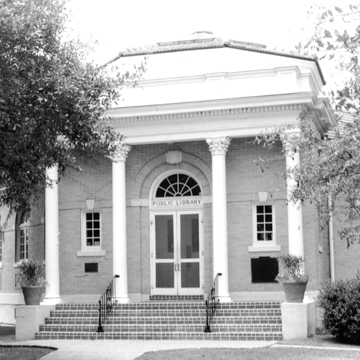In 1889, the Jennings Ladies' Library Association opened the first public library in Jennings, a town founded only four years previously as a stop on the Southern Pacific Railroad, in a house on Main Street purchased with funds they had raised. Their meeting minutes record that “so many northern homesteaders were pouring in [to the area] each week and came into Jennings for weekends with nowhere to go and little to see, that a reading room and library were necessary to their comfort.” After this first structure burned down in 1901, the association purchased the site of the present building and requested financial support for a new library from the Carnegie library program. However, as was typical of the time for financial dealings, one of the member’s husbands was obliged to undertake the negotiations. With a donation of $10,000 the women could proceed. The Carnegie program required the city also provide some funding and support ongoing maintenance of the building.
The library, set on a prominent corner lot on the edge of downtown, is constructed of buff-colored brick with white-painted wood trim. Its V-shaped plan fits neatly onto the site, and the street angle is marked by the library’s handsome entrance portico supported on four Corinthian columns and topped by an entablature and parapet. Classical designs are typical of the Carnegie libraries built in this time period. The exterior is reminiscent of Thomas Jefferson's Poplar Forest in Virginia. The portico leads inside to an octagonal rotunda with Ionic columns in each corner which is illuminated by a skylight in the octagonal dome; the rest of the interior has been remodeled. In 1952, the south wing was extended by four bays. The architects, Whitfield and King of New York City, designed several other Carnegie libraries, including those in Honolulu and Cleveland. No doubt they got the commissions because Henry D. Whitfield was Andrew Carnegie’s brother-in-law.














